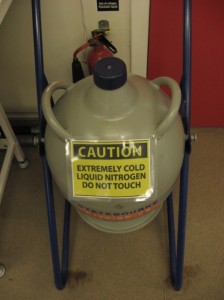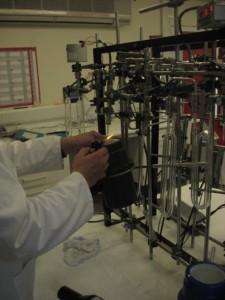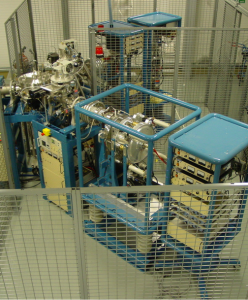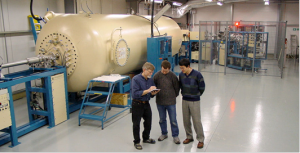I (Daniel) recently had the opportunity to visit the Natural Environment Research Council (NERC) Radiocarbon Facility – Environment (NRCF-EK), hosted at the Scottish Universities Environmental Research Centre (SUERC), a collaborative facility between the Universities of Glasgow and Edinburgh. The lab is located in East Kilbride, a 30-minute train ride south of Glasgow city centre.
The opportunity arose via an application I submitted with my Supervisor (Dr Richard Chiverrell) to the NCRF-Steering Committee for funding towards a series of radiocarbon (14C) dates for our lake sediment sequence at Brotherswater, northwest England. The dating rationale was to augment our current chronology in order to confirm the local mining history recorded in the lake sediment sequence (EGU abstract) as well as more confidently temporally correlate individual palaeoflood laminations with known historical floods (EGU abstract). I was delighted to be awarded 14 radiocarbon dates in total and being invited to bring my samples to their lab and observe the preparation procedures and analytical equipment they use seemed an excellent opportunity.
Pauline Gulliver, a Research Associate at the NRCF-EK lab and the manager of our project, kindly picked me up from the train station on Monday morning (Aug 19th). My first morning involved reading detailed Health and Safety briefings, which were by some margin the most interesting paperwork I have ever completed. The repeated mentions of liquid nitrogen, for example, were intriguing as my prior knowledge of its properties was only from movies.
Monday afternoon was more ‘hands-on’ and in fact, by the end of my three-day visit, I had been lucky enough to observe and attempt first-hand each different stage of sample pre-treatment. Callum Murray, the lab technician with whom I was working, was brilliant throughout, explaining each step in detail and with admirable patience. The gas lines (see photo) used for extracting various gases and cryogenically capturing the CO2 were visually impressive (and initially daunting when Callum suggested I attempt a sample myself). But he clearly explained the order in which each valve is turned in order to check for leaks, move gases through the liquid nitrogen and water traps, and measure the total CO2 captured so, in the end, it was great fun and I spent much of Tuesday doing this procedure. Once the sample CO2 is captured it is turned into a form of elemental carbon called graphite and I also watched this being compressed into a graphite pellet. It is this pellet that is subsequently placed on a large diameter tray and inserted into the AMS, enabling the 14C to be measured. I also had the opportunity to put some of my own samples in their Mass Spectrometer, with the help of technician Josanne Newton, in order to measure the ratio of 12C to 13C isotopes, which is used to correct the radiocarbon data for isotopic fractionation.
An important ‘known unknown’ within my knowledge of radiocarbon sample preparation prior to visiting the lab was how the glass vials containing CO2 are kept absolutely sealed from surrounding air and the possibility of mixing is minimised. Their method is extremely effective: using a butane torch, the narrow stem of the silicon glass vial is made molten and sealed shut (see photo). I had a few attempts with mixed results; another fun yet effective task.
Wednesday lunchtime Pauline and I visited the SUERC AMS lab where their enormous, powerful Accelorator Mass Spectrometer for measuring the carbon isotopes (as well as other selected cosmogenic isotopes) is housed in a purpose-built facility. Upon arrival, Philippa Ascough kindly volunteered her time to provide me with a fascinating guided tour. (On a side note, this demonstrates the power of Twitter as I’ve had one or two Twitter conversations with Philippa in recent months). I honestly cannot recall which aspect was most impressive; the size of the accelerator or the complexity of wiring visible through the casing perhaps. The fact such a large machine is needed when the particles sought to be measured are so small seemed astounding but Philippa’s explanations made this very clear. Truly one of the most impressive machines I’ve ever seen.
The SUERC Accelorator Mass Spectrometer. Photos used with the kind permission of Philippa Ascough, SUERC AMS Laboratory
I am very grateful to the NRCF-E staff and Philippa Ascough for taking the time out of their undoubtedly busy schedules to provide such an educational experience. I’ve taken a number of lessons from my visit to the NRFC-E lab; for one, it has inspired me to greatly improve my knowledge base of standard chemistry and physics. While the staff provided helpful explanations of the various reactions taking place and equipment being used, a solid understanding of the underlying mechanics can only be acquired through a better personal understanding. My visit confirmed yet again that hands-on, visual experience is undoubtedly the most effective learning tool; I don’t think reading every issue of Radiocarbon plus relevant textbooks could replace the knowledge I acquired during my visit (ignoring the time needed for all that reading!). Most importantly, I feel much more confident to discuss the radiocarbon dating technique in published papers or my viva, when the time comes.
Visiting the NRCF-EK lab was an invaluable experience that I’d recommend to any Early Career Researcher who has successfully been awarded funding from the Steering Committee towards 14C dates.





